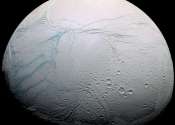Study explains how Enceladus ejects particles from oceans beneath its surface
Although it is relatively small, Enceladus—the sixth largest of Saturn's 83 moons—has been considered by astronomers to be one of the more compelling bodies in our solar system.









